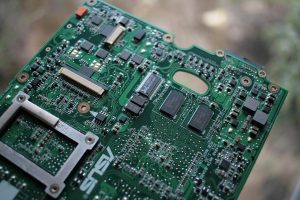Nvidia (NASDAQ:NVDA) has established itself as a leading force in the artificial intelligence accelerator market, propelling its market capitalization to over $4 trillion. The company’s financial results are impressive, showing a 56% revenue increase from the prior year, reaching $47 billion in the latest quarter, with net margins regularly exceeding 50%. However, historical precedents serve as a warning. In the cryptocurrency sector, GPUs once dominated but were eventually eclipsed by custom-designed ASICs that provided superior efficiency. With Broadcom recently announcing a significant $10 billion order for custom AI chips, believed to be from OpenAI, investors are beginning to contemplate whether AI could experience a similar transition. What implications could this have for Nvidia’s future?
Despite the allure of rapid growth, investing in a single stock involves considerable risk. The Trefis High Quality Portfolio aims to mitigate stock-specific risks while maintaining the potential for upside.
From CPUs to ASICs: The Bitcoin Mining Precedent
Initially, Bitcoin mining utilized standard CPUs. Miners soon discovered that GPUs were better equipped for the parallel computations required by Bitcoin’s algorithm. Although GPUs became the preferred hardware, they were later supplanted by FPGAs and ultimately ASICs (Application-Specific Integrated Circuits). ASICs revolutionized the scene, providing unparalleled efficiency and speed for Bitcoin’s hashing algorithm compared to GPUs. An individual ASIC miner could achieve terahashes per second while consuming significantly less power than GPU-based rigs.
The drawback of specialization arose: ASICs could only mine Bitcoin or similar algorithms, while GPUs maintained flexibility across different coins and applications, including gaming and AI. This transformation led to a capital-intensive mining landscape, increasingly dominated by large industrial operations capable of financing extensive ASIC farms. Nonetheless, GPUs remain favored among small miners, hobbyists, and for altcoins designed for GPU mining.
Could AI Be Next?
Nvidia’s GPUs are regarded as the gold standard for training large language models like OpenAI’s GPT-4, forming the backbone of AI infrastructure at major tech companies. Over the last three years, substantial investments in GPU clusters have fueled Nvidia’s rapid growth. For context, major corporations like Amazon, Alphabet, Microsoft, and Meta aim to collectively invest $364 billion in capital expenditures for their respective fiscal years. Yet, the economic landscape of AI is also evolving.
While training large models remains GPU-centric, the initial phase might be front-loaded. As the easily accessible online data is integrated into large language models, the incremental benefits from larger models could diminish, leading to a potential slowdown in training demand. The future demand is expected to shift towards inference—executing trained models at scale to handle billions of queries. This process is predictable and cost-sensitive, creating an ideal environment for custom chips to excel, similar to the role ASICs played in Bitcoin.
Drawbacks of ASICs
The benefits of ASICs in both crypto and AI are evident: efficiency, lower power usage, and consistency for repetitive tasks. For companies scaling AI operations, these advantages may seem compelling. However, drawbacks exist. Once an ASIC is produced, its functionality is largely fixed, in contrast to GPUs that can be reprogrammed or updated as needed. Just as Bitcoin ASICs were restricted to the SHA-256 algorithm and vulnerable to changes in the protocol, AI-focused chips may lack the flexibility of GPUs. Rapid advancements in AI models or architectures could render ASICs obsolete. GPUs, on the other hand, remain versatile, capable of managing both training and inference across various models, though designing and producing ASICs can be a costly and lengthy process, limiting access for smaller enterprises.
Implications for Nvidia
The primary concern for Nvidia is that its main growth driver—GPUs for AI—may not be as stable as presumed. While training workloads will likely continue to rely on GPUs, the potential shift toward custom silicon for inference could threaten Nvidia’s market share. Broadcom’s recent deal might signify the start of a wider trend, as hyperscalers like Google, Amazon, and Meta consider similar strategies while developing their own chips. Nvidia still holds competitive advantages, including a well-established ecosystem and a robust software stack (CUDA) that aids in customer retention. Nonetheless, the looming threat of ASICs is something investors need to monitor closely, especially given Nvidia’s current high valuations and strong market momentum.
The Trefis High Quality (HQ) Portfolio, comprising 30 stocks, has consistently outperformed benchmarks, including the S&P 500, Russell, and midcap S&P. This portfolio has historically yielded better returns with reduced risk, avoiding extreme volatility as demonstrated in the HQ Portfolio performance metrics.



